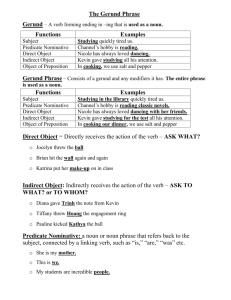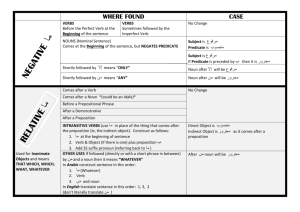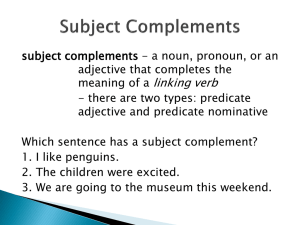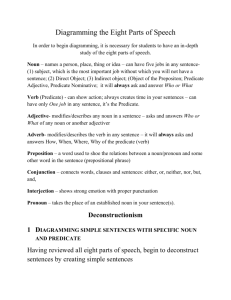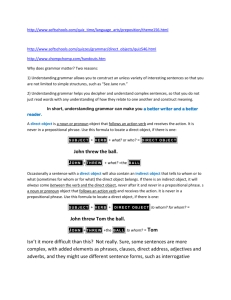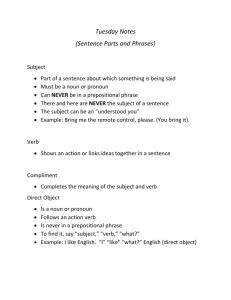Chapter 4: Simple Declarative Sentence
advertisement
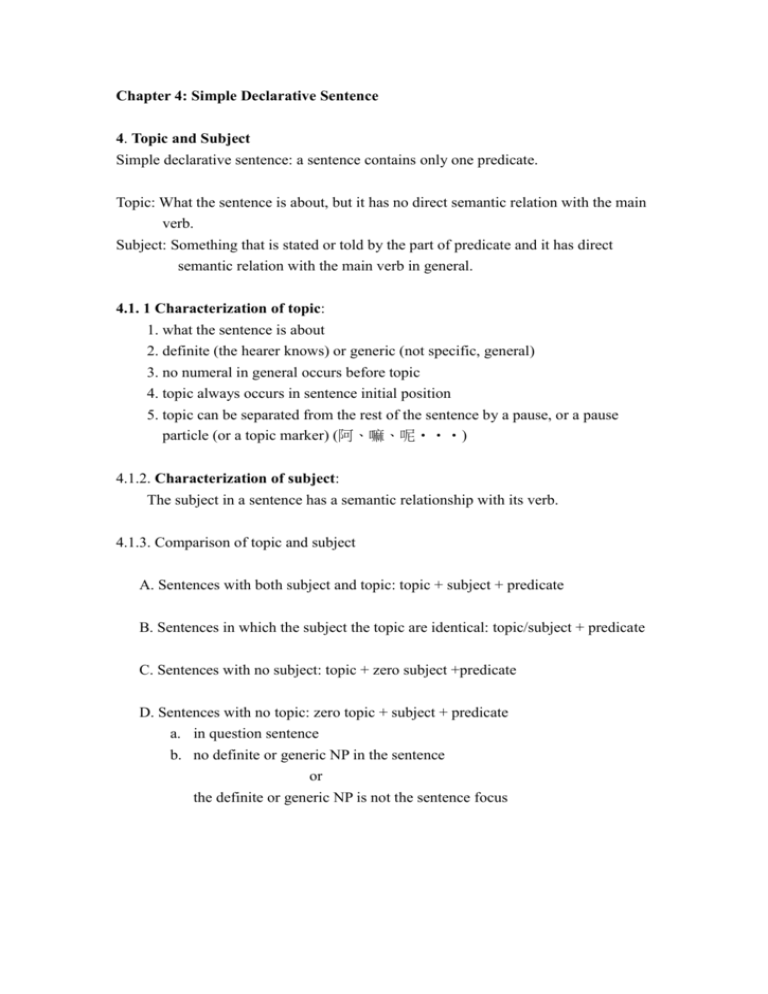
Chapter 4: Simple Declarative Sentence 4. Topic and Subject Simple declarative sentence: a sentence contains only one predicate. Topic: What the sentence is about, but it has no direct semantic relation with the main verb. Subject: Something that is stated or told by the part of predicate and it has direct semantic relation with the main verb in general. 4.1. 1 Characterization of topic: 1. what the sentence is about 2. definite (the hearer knows) or generic (not specific, general) 3. no numeral in general occurs before topic 4. topic always occurs in sentence initial position 5. topic can be separated from the rest of the sentence by a pause, or a pause particle (or a topic marker) (阿、嘛、呢‧‧‧) 4.1.2. Characterization of subject: The subject in a sentence has a semantic relationship with its verb. 4.1.3. Comparison of topic and subject A. Sentences with both subject and topic: topic + subject + predicate B. Sentences in which the subject the topic are identical: topic/subject + predicate C. Sentences with no subject: topic + zero subject +predicate D. Sentences with no topic: zero topic + subject + predicate a. in question sentence b. no definite or generic NP in the sentence or the definite or generic NP is not the sentence focus 4.1.4-5 Double-Subject Sentences: topic + subject + predicate A. Chao’s analysis 1. Grammatically, the first NP in a sentence is subject, and the rest of it is predicate ( grammatical structure) 2. Functionally/Semantically, the first NP is topic, and the rest of it is comment (an information structure/say words about) 4.1.6. Time and Locative Phrases as topic Reasons: 1. initial position 2. it can be separated by a pause 3. definite 4.1.7. Topic can appear in subordinate clause if the main verb is a verb of saying (say, suggest, etc.) or a verb of mental activity (feel, think, etc.) 4.1.8. Topic as a discourse element A. Topic is often the part of the preceding sentence B. Topic is used to contrast 4.1.9. Topic and coreference in discourse Topic is often the antecedent of a zero NP in a sentence. 4.2. The Noun Phrase: a group of words with a noun or pronoun as the head. The noun phrase may consist of only one word or it may be long and complex. 4.2.1 Classifier/Measure word: a word used with a noun, which shows the subclass to which the noun belongs. 4.2.2 Associative phrases: NP — (de) + NP (where NP — (de) is an associative phrase) 4.2.3 Modifying phrases: Relative clause/attributive adjective + NP 4.2.4. The order of elements in an NP Order 1: (associative phrase) + (classifier/measure phrase) + (relative clause) + (adjective) + noun Order 2: (associative phrase) + (relative clause) + (classifier/measure phrase) + (adjective) + noun definite 4.2.5 Definiteness and Referentiality ↗ referential ↗ ↘ NP indefinite ↘ nonreferential 4.2.6 Pronouns 1. A pronoun must be coreferential with an NP 2. No modifier can be placed before a pronoun 4.2.7 Reflexives: (pronoun) + ziji 1. a reflexive is always coreferential with the subject of the sentence. 2. adverblike usage (contrast oneself with others) 4.3 The Verb Phrase 4.3.1 Types of verb phrase 1. Transitive VP: V + O 2. Intransitive VP: a. adjectival b. copula c. others 3. Ditransitive VP: V + IO + DO

